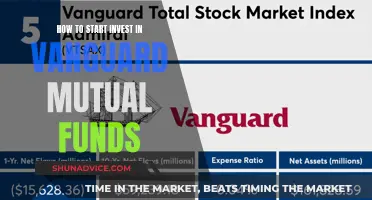
There are thousands of mutual funds to choose from, so it's natural to feel overwhelmed when deciding where to put your money. As you research and compare options, here are some factors to consider.
Firstly, you should understand the difference between actively and passively managed mutual funds. Actively managed funds have portfolio managers who make decisions regarding which securities and assets to include in the fund. Passive funds, on the other hand, seek to track and duplicate the performance of a benchmark index.
Secondly, you should know how much the mutual fund costs. The main type of fee is the expense ratio, which is the percentage of the fund's assets that go towards annual fees. Passive funds tend to have lower expense ratios than active funds.
You should also consider your investment goals and risk tolerance. For example, if you are investing for retirement, it is usually best to keep your money invested for the long haul.
Additionally, you may want to diversify your portfolio. Keeping your portfolio diversified is one of the most effective ways to ensure long-term outperformance and stability.
Finally, stay focused on long-term growth. Do your research and consider meeting with a financial advisor.
| Characteristics | Values |
|---|---|
| Investment goals | Long-term capital gains, current income, college expenses, retirement |
| Risk tolerance | Dramatic swings in portfolio value, conservative investment |
| Time horizon | Long-term, short-term |
| Management style | Active, passive |
| Costs | Expense ratio, sales fee (load), transaction fees, management fee, distribution fee, other expenses |
| Performance | Past performance, volatility, Morningstar rating, long-term performance |
| Diversification | Single fund, multiple funds |
| Investment amount | Minimum investment amount |
What You'll Learn

Consider your investment goals and risk tolerance
When choosing a mutual fund to invest in, it is important to consider your investment goals and risk tolerance. Mutual funds are investment instruments that pool money from various investors to invest in assets such as stocks and bonds to meet the investors' goals. There are different types of mutual funds, each with varying levels of risk and potential returns. Thus, it is crucial to understand your financial objectives, risk tolerance, and investment horizon before selecting a fund.
Firstly, identify your investment goals. Are you investing for the long term, such as retirement, or do you have shorter-term goals? Long-term capital gains or current income may be your objective. For example, if you are building an emergency fund, your investment horizon may be short, and you may opt for a more conservative investment strategy.
Secondly, assess your risk tolerance. Can you tolerate significant swings in your portfolio's value, or do you prefer a more stable investment? Your risk tolerance depends on factors such as your financial obligations, age, income, and personality. Aggressive investors, typically with a higher risk tolerance, are willing to risk losing money for the potential of better returns. In contrast, conservative investors seek guaranteed returns and are averse to volatility.
Your investment goals and risk tolerance will help determine the appropriate asset allocation for your portfolio. If you have a long investment horizon and a high-risk tolerance, you may opt for all-stock mutual funds. On the other hand, if you seek more stability, you may prefer mutual funds with more exposure to bonds or other fixed-income investments.
Additionally, consider the time horizon for your investments. If you need access to your money within a short period, an aggressive growth fund may not be suitable. Target-date funds are a good option if you want a fund with a built-in time horizon, as they adjust their risk level based on your proximity to retirement age.
By understanding your investment goals, risk tolerance, and time horizon, you can choose a mutual fund that aligns with your financial objectives and helps you build a well-diversified portfolio.
A Beginner's Guide to Investing in Vanguard Funds
You may want to see also

Understand the fund's management style
Understanding the management style of a mutual fund is an important aspect of choosing the right fund for your investment goals. The investment style of a mutual fund helps set expectations for risk and performance potential and is a key marketing tool used by fund managers to attract investors looking for a specific type of market exposure.
Risk Tolerance
Conservative, moderate, or aggressive risk tolerance is a primary differentiator that helps mutual fund companies market their products to investors. Conservative funds tend to focus on income and fixed-income investments, such as money market funds, loan funds, and bond funds. These funds are generally good for investors seeking steady income, with many paying interest distributions or reinvesting in capital appreciation growth. Moderate-risk investors may be attracted to managed funds with large-cap, blue-chip securities or a value investment style. Aggressive investors, on the other hand, may prefer growth funds, aggressive growth funds, capital opportunity funds, or alternative hedge fund investment styles that offer broader flexibility in terms of leverage and derivatives usage.
Growth vs. Value
Another important distinction in investment styles is growth vs. value. Growth stocks are shares in companies that have the potential to outperform the overall market over time due to their future prospects. Value stocks, on the other hand, are shares trading below their intrinsic worth and are expected to provide superior returns in the long run. The decision to invest in growth or value stocks depends on an investor's preference, risk tolerance, investment goals, and time horizon. It's worth noting that over shorter periods, the performance of growth or value stocks will also depend on the market cycle.
Market Capitalization
Market capitalization, or market cap, is another factor that influences investment styles. Funds may focus on large-cap, mid-cap, or small-cap stocks. Large-cap companies are typically blue-chip firms with established businesses and committed dividend payout ratios, making them attractive to income investors. Small-cap stocks, on the other hand, tend to be newer and riskier investments, often associated with startup companies or new businesses.
Active vs. Passive Management
Fund managers may also take an active or passive approach to managing a fund's portfolio. An active fund manager seeks to outperform the market by actively picking stocks and shifting allocations based on their investing strategy and research. In contrast, a passive fund manager aims to replicate the performance of a specific market index, such as the S&P 500 or DJIA, by holding the same assets in the same proportions. Passive funds tend to have lower fees since they require less research and analysis.
Style Box
The style box, popularized by Morningstar, is a graphical representation of a mutual fund's characteristics, including market capitalization and investment style (value, blend, or growth). It provides a quick way to gauge the fundamental characteristics of a mutual fund's investment strategy and potential risk and return profile. Investors can use the style box to compare and contrast different mutual funds and find those that align with their specific goals and risk tolerance.
Best Mutual Funds for One-Time Investments: Where to Invest?
You may want to see also

Evaluate fees and costs
When it comes to investing in mutual funds, fees and costs are an important consideration. Here are some key things to keep in mind:
Expense Ratio
The expense ratio is the percentage of fund assets charged to cover fund expenses. It includes management fees, distribution fees, and other expenses. Actively managed mutual funds tend to have higher expense ratios, typically ranging from 0.65% to 1.45%, as they have to pay investment managers. On the other hand, passively managed funds or index funds have lower expense ratios, usually between 0.03% and 0.25%, as they don't require active management. According to Fidelity, the average expense ratio for actively managed funds is 1.45%, while it's 0.73% for index funds.
Sales Load or Commission
Some mutual funds charge a sales commission, also known as a load or sales fee. This can be front-end or back-end. A front-end load is paid when you buy into the fund, while a back-end load is paid when you sell your shares. Loads typically range from 1% to 2% but can go as high as 8.5% by law. However, many great mutual funds don't charge any load, so it's generally advisable to avoid funds with these fees.
Transaction Fees
Transaction fees, also known as loads, are charged by some funds when buying or selling shares. These fees reduce your initial investment and can have a long-lasting impact. However, funds without transaction fees may charge higher ongoing fees, so it's essential to compare total costs.
Turnover
Turnover indicates how often the fund's management team trades or buys and sells securities. A fund with high turnover may incur more transaction fees and generate more short-term capital gains, which are taxed at a higher rate. On the other hand, a fund with lower turnover may result in lower costs and more long-term capital gains, which are taxed at a preferential rate.
Other Fees
In addition to the fees mentioned above, there may be other costs associated with mutual funds, such as 12b-1 fees. These fees are used for promotions, sales, and distribution of fund shares and can be as high as 1% of your investment.
When evaluating mutual funds, it's crucial to consider all fees and costs involved. While a particular fund may have excellent performance, high fees can eat into your returns over time. Therefore, it's essential to compare the expense ratios, loads, transaction fees, and other costs before making an investment decision.
IRA Funds: TD Ameritrade Investment Strategies for Beginners
You may want to see also

Research the fund's past performance
When researching a mutual fund's past performance, it's important to remember that past performance does not guarantee future results. However, there are several factors you can consider to help you evaluate a mutual fund's past performance and make a more informed investment decision.
Firstly, determine the fund's investment style and whether it aligns with your objectives. Mutual funds can be classified based on growth or value orientation, company size, and passive or active investing strategies. Websites like Morningstar provide valuable insights into a fund's investment style, performance data, and tools to facilitate your evaluation.
Next, review the fund's historical performance data and compare it with its peers. Assess the consistency of returns over several years and evaluate how the fund has navigated market downturns. Morningstar ranks funds based on risk and historical returns, allowing you to identify funds that assume more or less risk relative to their peers. Additionally, compare the fund's upside and downside data with similar funds to gain a deeper understanding of its performance.
It's also essential to consider the fund's fees and expenses. Tactical mutual funds with high trading activity or active management tend to have higher annual expenses, which can impact your real rate of return. While higher management fees don't necessarily indicate better or worse performance, it's important to be mindful of reasonable expense ratios within the type of fund you're considering. Comparing fees with similar funds can help you assess if the fund is a good fit for your portfolio.
While past performance doesn't guarantee future outcomes, evaluating a mutual fund's historical returns, investment style, fees, and comparing it with its peers can provide valuable insights to make more informed investment decisions.
Target Date Funds: A Guide to Investing for Retirement
You may want to see also

Diversify your portfolio
Diversifying your portfolio is a crucial step in reducing risk and enhancing returns. Here are some essential tips to help you diversify your portfolio effectively:
Understand the Basics of Diversification:
Diversification is a strategy that involves spreading your investments across different types of investments, which reduces risk while still allowing your money to grow. It’s one of the most basic principles of investing.
Diversify Across Asset Classes:
Invest in a mix of stocks, bonds, and short-term investments. Stocks represent the aggressive portion of your portfolio, offering higher growth potential but with greater risk. Bonds, on the other hand, provide regular interest income and are generally less volatile, acting as a cushion against stock market fluctuations. Short-term investments like money market funds and CDs offer stability and easy access to your money but may provide lower returns.
Allocate Across Different Sectors and Industries:
Diversify your stock holdings by investing in various sectors, such as technology, healthcare, financials, etc. You can also explore commodity-focused funds that invest in industries like oil and gas, mining, and natural resources, which can provide a hedge against inflation. Additionally, consider investing in real estate investment trusts (REITs) to further diversify your portfolio and protect against inflationary risks.
Invest Internationally:
Adding international stocks to your portfolio can provide exposure to opportunities not offered by domestic securities. When the domestic market experiences a downturn, international markets may still be thriving, helping to balance your portfolio.
Choose Different Types of Mutual Funds:
Invest in a mix of growth and income funds, growth funds, aggressive growth funds, and international funds. Growth and income funds typically consist of large-cap stocks from established companies, offering more predictable returns with lower risk. Growth funds focus on mid-cap companies with higher growth potential. Aggressive growth funds are typically small-cap funds with the highest risk but also the highest potential rewards. International funds provide exposure to global markets, reducing the impact of domestic downturns.
Regularly Review and Rebalance:
Your portfolio's value will fluctuate over time as market conditions change. Therefore, it's essential to regularly review your investments and rebalance your portfolio to maintain your desired allocation across different asset classes and fund types. Consider meeting with an investment professional to help you make informed decisions about adjusting your portfolio.
Remember, diversification is a long-term strategy, and it's essential to stay disciplined and consistent. Don't react to short-term market fluctuations but focus on your long-term financial goals.
How Fed Funds Rate Cuts Impact Investment Decisions
You may want to see also
Frequently asked questions
There are a few key criteria to help you narrow down the vast array of mutual funds. Firstly, consider your overall investment strategy and how a particular fund fits into it. Think about your financial situation, goals, timeline, and risk tolerance. Secondly, evaluate the fund's performance, but don't rely solely on recent results. Lastly, factor in the cost, including the expense ratio and transaction fees.
Actively managed funds have portfolio managers who actively select and trade securities, aiming to beat a benchmark index. They often incur higher fees to compensate fund managers. Passively managed funds, or index funds, aim to track and duplicate the performance of a benchmark index, typically incurring lower fees.
When evaluating a fund's past performance, ask yourself: Did the fund's returns align with general market returns? Was the fund more volatile than major indexes? Was there a high turnover that could impose additional costs and tax liabilities? Also, review the fund's prospectus and consider the fund's size and how it may impact its ability to meet its investment objectives.







